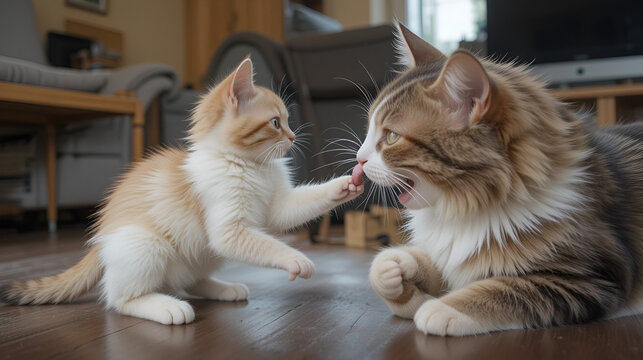Bringing a new kitten into your home is an exciting time, filled with playful antics and adorable moments. However, the process of introducing a new, particularly underage, kitten to existing feline residents requires careful planning and execution. Rushing the process can lead to stress, fear, and even aggression, impacting the well-being of all cats involved. This guide provides a comprehensive overview of how to safely and successfully integrate a young kitten into your existing cat household, ensuring a peaceful and loving environment for everyone.
Understanding the Challenges of Introducing Young Kittens
Underage kittens, typically those under 12 weeks of age, are especially vulnerable during introductions. They are still developing their social skills and immune systems, making them more susceptible to stress and illness. They also rely heavily on their mother for comfort and security, so being separated from her and placed in a new environment can be particularly traumatic.
Furthermore, adult cats may perceive a young kitten as a threat or an annoyance. Adult cats establish a hierarchy in the household, and the introduction of a new kitten can disrupt this established order. Some adult cats may exhibit territorial behavior, such as hissing, swatting, or chasing the kitten. Others may simply ignore the kitten, which can still be stressful for the young feline.
Preparing for the Arrival of Your New Kitten
Before you even bring your new kitten home, it’s crucial to prepare your house to minimize stress and maximize the chances of a successful introduction. This preparation involves several key steps:
- Separate Spaces: Designate a safe room for the new kitten. This room should be equipped with everything the kitten needs: food, water, a litter box, scratching post, toys, and a comfortable bed. This room will serve as the kitten’s sanctuary during the initial introduction phase.
- Scent Soaking: Before the kitten arrives, rub a clean cloth on your resident cat(s), paying particular attention to their cheeks and head. Then, place this cloth in the kitten’s safe room. Similarly, rub a cloth on the kitten and place it near your resident cat(s)’ favorite spots. This allows the cats to become familiar with each other’s scents without direct interaction.
- Pheromone Diffusers: Consider using a feline pheromone diffuser, such as Feliway, in the house. These diffusers release synthetic pheromones that mimic the natural pheromones produced by cats, which can help to reduce stress and promote a sense of calm.
- Veterinary Check-up: Before introducing the kitten to your resident cats, ensure that the kitten has been examined by a veterinarian. This is important to rule out any underlying health issues that could be contagious. It’s also a good idea to have your resident cats checked up as well, ensuring everyone is healthy and vaccinated.
The Gradual Introduction Process: A Step-by-Step Guide
The key to successfully mixing underage kittens with resident cats is to take things slowly and gradually. Rushing the process can lead to negative experiences and potentially damage the relationship between the cats.
Phase 1: Scent Exchange and Visual Introduction
- Controlled Sniffing: After the kitten has settled into its safe room for a few days, begin allowing the cats to sniff each other under the door. You can also swap the cats’ bedding or toys to further facilitate scent exchange.
- Brief Visual Encounters: Once the cats seem comfortable with each other’s scents, you can begin allowing brief, supervised visual encounters. This can be done by cracking the door slightly or using a baby gate. Observe the cats’ body language carefully. If either cat shows signs of aggression, such as hissing, growling, or swatting, immediately separate them and try again later.
Phase 2: Supervised Interactions in a Larger Space
- Controlled Playtime: If the initial visual encounters go well, you can begin allowing the cats to interact in a larger, supervised space. Start with short periods of time and gradually increase the duration as the cats become more comfortable.
- Positive Reinforcement: Use positive reinforcement, such as treats and praise, to reward calm and friendly behavior. This will help the cats associate each other with positive experiences.
- Observe Body Language: Pay close attention to the cats’ body language during these interactions. Watch for signs of stress, such as flattened ears, dilated pupils, or a tucked tail. If you see any of these signs, separate the cats immediately.
Phase 3: Unsupervised Access
- Gradual Freedom: Once the cats are consistently interacting peacefully under supervision, you can begin allowing them unsupervised access to the house. Start with short periods of time and gradually increase the duration as the cats become more comfortable.
- Multiple Resources: Ensure that there are plenty of resources available throughout the house, such as food bowls, water bowls, litter boxes, scratching posts, and beds. This will help to reduce competition and territorial behavior.
- Continued Monitoring: Even after the cats are living together harmoniously, it’s important to continue monitoring their interactions. Be prepared to intervene if any problems arise.
Troubleshooting Common Challenges
Even with careful planning, some challenges may arise during the introduction process. Here are some tips for troubleshooting common issues:
- Aggression: If either cat exhibits aggressive behavior, such as hissing, growling, or swatting, separate them immediately and consult with a veterinarian or a certified cat behaviorist.
- Fear: If the kitten is fearful, provide plenty of hiding places and allow it to approach you at its own pace. Avoid forcing interaction.
- Inappropriate Elimination: Stress can sometimes lead to inappropriate elimination. Ensure that there are enough litter boxes available and that they are kept clean.
Patience and Consistency are Key
Introducing a new kitten to resident cats, especially when mixing underage kittens into the mix, requires patience, consistency, and a keen understanding of feline behavior. By following these guidelines and paying close attention to the cats’ body language, you can create a harmonious and loving environment for all your feline companions. Remember that every cat is different, and some introductions may take longer than others. Don’t get discouraged if you encounter setbacks. With persistence and a little bit of luck, you can successfully integrate your new kitten into your existing cat family.

